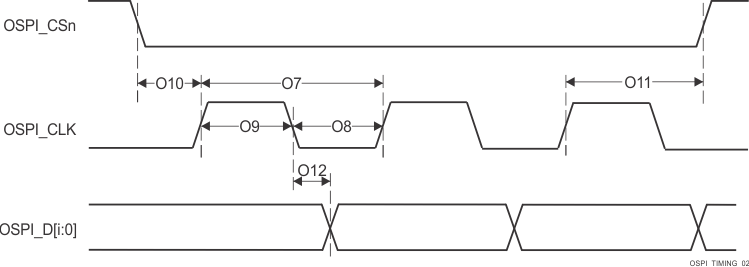JAJSU80 March 2024
ADVANCE INFORMATION
- 1
- 1 特長
- 2 アプリケーション
- 3 概要
- 4 Device Comparison
-
5 Terminal Configuration and Functions
- 5.1 Pin Diagrams
- 5.2 Pin Attributes
- 5.3
Signal Descriptions
- 13
- 5.3.1 CPSW3G
- 5.3.2 CPTS
- 5.3.3 CSI-2
- 5.3.4 DDRSS
- 5.3.5 DSI
- 5.3.6 DSS
- 5.3.7 ECAP
- 5.3.8 Emulation and Debug
- 5.3.9 EPWM
- 5.3.10 EQEP
- 5.3.11 GPIO
- 5.3.12 GPMC
- 5.3.13 I2C
- 5.3.14 MCAN
- 5.3.15 MCASP
- 5.3.16 MCSPI
- 5.3.17 MDIO
- 5.3.18 MMC
- 5.3.19 OLDI
- 5.3.20 OSPI
- 5.3.21 Power Supply
- 5.3.22 Reserved
- 5.3.23 SERDES
- 5.3.24 System and Miscellaneous
- 5.3.25 TIMER
- 5.3.26 UART
- 5.3.27 USB
- 5.4 Pin Connectivity Requirements
-
6 Specifications
- 6.1 Absolute Maximum Ratings
- 6.2 ESD Ratings for AEC - Q100 Qualified Devices in the AMW Package
- 6.3 Power-On Hours (POH)
- 6.4 Recommended Operating Conditions
- 6.5 Operating Performance Points
- 6.6
Electrical
Characteristics
- 6.6.1 I2C Open-Drain, and Fail-Safe (I2C OD FS) Electrical Characteristics
- 6.6.2 Fail-Safe Reset (FS RESET) Electrical Characteristics
- 6.6.3 High-Frequency Oscillator (HFOSC) Electrical Characteristics
- 6.6.4 Low-Frequency Oscillator (LFXOSC) Electrical Characteristics
- 6.6.5 SDIO Electrical Characteristics
- 6.6.6 LVCMOS Electrical Characteristics
- 6.6.7 CSI-2 (D-PHY) Electrical Characteristics
- 6.6.8 USB2PHY Electrical Characteristics
- 6.6.9 DDR Electrical Characteristics
- 6.7 VPP Specifications for One-Time Programmable (OTP) eFuses
- 6.8 Thermal Resistance Characteristics
- 6.9
Timing and Switching Characteristics
- 6.9.1 Timing Parameters and Information
- 6.9.2 Power Supply Requirements
- 6.9.3 System Timing
- 6.9.4 Clock Specifications
- 6.9.5
Peripherals
- 6.9.5.1 ATL
- 6.9.5.2 CPSW3G
- 6.9.5.3 CPTS
- 6.9.5.4 CSI-2
- 6.9.5.5 CSI-2 TX
- 6.9.5.6 DDRSS
- 6.9.5.7 DSS
- 6.9.5.8 ECAP
- 6.9.5.9 Emulation and Debug
- 6.9.5.10 EPWM
- 6.9.5.11 EQEP
- 6.9.5.12 GPIO
- 6.9.5.13 GPMC
- 6.9.5.14 I2C
- 6.9.5.15 MCAN
- 6.9.5.16 MCASP
- 6.9.5.17 MCSPI
- 6.9.5.18 MMCSD
- 6.9.5.19 OSPI
- 6.9.5.20 PCIe
- 6.9.5.21 Timers
- 6.9.5.22 UART
- 6.9.5.23 USB
- 7 Detailed Description
-
8 Applications,
Implementation, and Layout
- 8.1 Device Connection and Layout Fundamentals
- 8.2 Peripheral- and Interface-Specific Design Information
- 8.3 Clock Routing Guidelines
- 9 Device and Documentation Support
- 10Revision History
- 11Mechanical, Packaging, and Orderable Information
6.9.5.19.1.2.1 OSPI0 PHY SDR Timing
Table 6-115 defines DLL delays required for OSPI0 PHY SDR Mode. Table 6-121, Figure 6-99, Figure 6-100, Table 6-122, and Figure 6-101 present timing requirements and switching characteristics for OSPI0 PHY SDR Mode.
Table 6-115 OSPI0 DLL
Delay Mapping for PHY SDR Timing Modes
| MODE | OSPI_PHY_CONFIGURATION_REG BIT FIELD | DELAY VALUE |
|---|---|---|
| Transmit | ||
| All modes | PHY_CONFIG_TX_DLL_DELAY_FLD, | 0x0 |
| Receive | ||
| All modes | PHY_CONFIG_RX_DLL_DELAY_FLD | 0x0 |
Table 6-116 OSPI0 Timing Requirements –
PHY SDR Mode see Figure 6-99 and Figure 6-100
| NO. | MODE | MIN | MAX | UNIT | ||
|---|---|---|---|---|---|---|
| O19 | tsu(D-CLK) | Setup time, OSPI0_D[7:0] valid before active OSPI0_CLK edge | 1.8V, SDR with Internal PHY Loopback | 4.8 | ns | |
| 3.3V, SDR with Internal PHY Loopback | 5.19 | ns | ||||
| O20 | th(CLK-D) | Hold time, OSPI0_D[7:0] valid after active OSPI0_CLK edge | 1.8V, SDR with Internal PHY Loopback | -0.5 | ns | |
| 3.3V, SDR with Internal PHY Loopback | -0.5 | ns | ||||
| O21 | tsu(D-LBCLK) | Setup time, OSPI0_D[7:0] valid before active OSPI0_DQS edge | 1.8V, SDR with External Board Loopback | 0.6 | ns | |
| 3.3V, SDR with External Board Loopback | 0.9 | ns | ||||
| O22 | th(LBCLK-D) | Hold time, OSPI0_D[7:0] valid after active OSPI0_DQS edge | 1.8V, SDR with External Board Loopback | 1.7 | ns | |
| 3.3V, SDR with External Board Loopback | 2.0 | ns | ||||
 Figure 6-99 OSPI0
Timing Requirements – PHY SDR with Internal PHY Loopback
Figure 6-99 OSPI0
Timing Requirements – PHY SDR with Internal PHY Loopback Figure 6-100 OSPI0
Timing Requirements – PHY SDR with External Board Loopback
Figure 6-100 OSPI0
Timing Requirements – PHY SDR with External Board LoopbackTable 6-117 OSPI0 Switching
Characteristics – PHY SDR Mode see Figure 6-101
| NO. | PARAMETER | MODE | MIN | MAX | UNIT | |
|---|---|---|---|---|---|---|
| O7 | tc(CLK) | Cycle time, OSPI0_CLK | 1.8V | 7 | ns | |
| 3.3V | 6.03 | ns | ||||
| O8 | tw(CLKL) | Pulse duration, OSPI0_CLK low | ((0.475P(1)) - 0.3) | ns | ||
| O9 | tw(CLKH) | Pulse duration, OSPI0_CLK high | ((0.475P(1)) - 0.3) | ns | ||
| O10 | td(CSn-CLK) | Delay time, OSPI0_CSn[3:0] active edge to OSPI0_CLK rising edge | ((0.475P(1)) + (0.975M(2)R(4)) - 1) | ((0.525P(1)) + (1.025M(2)R(4)) + 1) | ns | |
| O11 | td(CLK-CSn) | Delay time, OSPI0_CLK rising edge to OSPI0_CSn[3:0] inactive edge | ((0.475P(1)) + (0.975N(3)R(4)) - 1) | ((0.525P(1)) + (1.025N(3)R(4)) + 1) | ns | |
| O12 | td(CLK-D) | Delay time, OSPI0_CLK active edge to OSPI0_D[7:0] transition | 1.8V | -1.16 | 1.25 | ns |
| 3.3V | -1.33 | 1.51 | ns | |||
(1) P = SCLK cycle time
in ns = OSPI0_CLK cycle time in ns
(2) M =
OSPI_DEV_DELAY_REG[D_INIT_FLD]
(3) N = OSPI_DEV_DELAY_REG[D_AFTER_FLD]
(4) R = reference clock
cycle time in ns
 Figure 6-101 OSPI0
Switching Characteristics – PHY SDR
Figure 6-101 OSPI0
Switching Characteristics – PHY SDR